Zhi Gao
School of Remote Sensing and Information Engineering, Wuhan University, Wuhan, China
Modality Alignment across Trees on Heterogeneous Hyperbolic Manifolds
Oct 31, 2025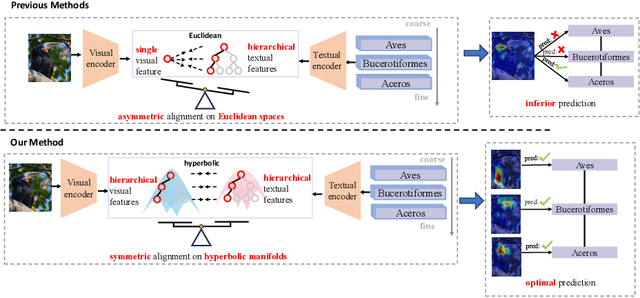
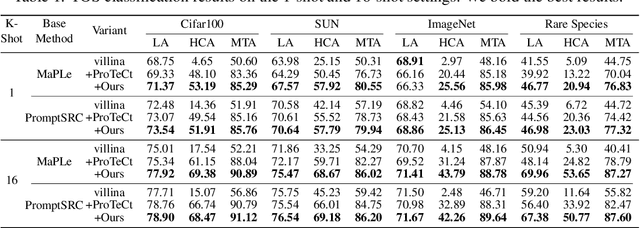
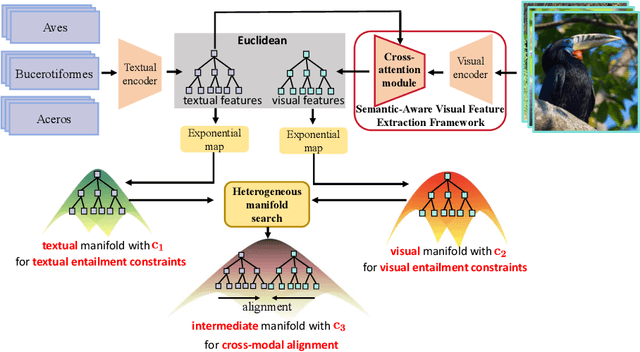

Abstract:Modality alignment is critical for vision-language models (VLMs) to effectively integrate information across modalities. However, existing methods extract hierarchical features from text while representing each image with a single feature, leading to asymmetric and suboptimal alignment. To address this, we propose Alignment across Trees, a method that constructs and aligns tree-like hierarchical features for both image and text modalities. Specifically, we introduce a semantic-aware visual feature extraction framework that applies a cross-attention mechanism to visual class tokens from intermediate Transformer layers, guided by textual cues to extract visual features with coarse-to-fine semantics. We then embed the feature trees of the two modalities into hyperbolic manifolds with distinct curvatures to effectively model their hierarchical structures. To align across the heterogeneous hyperbolic manifolds with different curvatures, we formulate a KL distance measure between distributions on heterogeneous manifolds, and learn an intermediate manifold for manifold alignment by minimizing the distance. We prove the existence and uniqueness of the optimal intermediate manifold. Experiments on taxonomic open-set classification tasks across multiple image datasets demonstrate that our method consistently outperforms strong baselines under few-shot and cross-domain settings.
GUI Knowledge Bench: Revealing the Knowledge Gap Behind VLM Failures in GUI Tasks
Oct 30, 2025Abstract:Large vision language models (VLMs) have advanced graphical user interface (GUI) task automation but still lag behind humans. We hypothesize this gap stems from missing core GUI knowledge, which existing training schemes (such as supervised fine tuning and reinforcement learning) alone cannot fully address. By analyzing common failure patterns in GUI task execution, we distill GUI knowledge into three dimensions: (1) interface perception, knowledge about recognizing widgets and system states; (2) interaction prediction, knowledge about reasoning action state transitions; and (3) instruction understanding, knowledge about planning, verifying, and assessing task completion progress. We further introduce GUI Knowledge Bench, a benchmark with multiple choice and yes/no questions across six platforms (Web, Android, MacOS, Windows, Linux, IOS) and 292 applications. Our evaluation shows that current VLMs identify widget functions but struggle with perceiving system states, predicting actions, and verifying task completion. Experiments on real world GUI tasks further validate the close link between GUI knowledge and task success. By providing a structured framework for assessing GUI knowledge, our work supports the selection of VLMs with greater potential prior to downstream training and provides insights for building more capable GUI agents.
KORE: Enhancing Knowledge Injection for Large Multimodal Models via Knowledge-Oriented Augmentations and Constraints
Oct 22, 2025Abstract:Large Multimodal Models encode extensive factual knowledge in their pre-trained weights. However, its knowledge remains static and limited, unable to keep pace with real-world developments, which hinders continuous knowledge acquisition. Effective knowledge injection thus becomes critical, involving two goals: knowledge adaptation (injecting new knowledge) and knowledge retention (preserving old knowledge). Existing methods often struggle to learn new knowledge and suffer from catastrophic forgetting. To address this, we propose KORE, a synergistic method of KnOwledge-oRientEd augmentations and constraints for injecting new knowledge into large multimodal models while preserving old knowledge. Unlike general text or image data augmentation, KORE automatically converts individual knowledge items into structured and comprehensive knowledge to ensure that the model accurately learns new knowledge, enabling accurate adaptation. Meanwhile, KORE stores previous knowledge in the covariance matrix of LMM's linear layer activations and initializes the adapter by projecting the original weights into the matrix's null space, defining a fine-tuning direction that minimizes interference with previous knowledge, enabling powerful retention. Extensive experiments on various LMMs, including LLaVA-v1.5-7B, LLaVA-v1.5-13B, and Qwen2.5-VL-7B, show that KORE achieves superior new knowledge injection performance and effectively mitigates catastrophic forgetting.
Beyond the Seen: Bounded Distribution Estimation for Open-Vocabulary Learning
Oct 06, 2025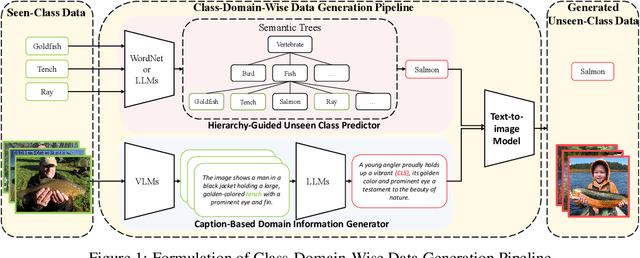



Abstract:Open-vocabulary learning requires modeling the data distribution in open environments, which consists of both seen-class and unseen-class data. Existing methods estimate the distribution in open environments using seen-class data, where the absence of unseen classes makes the estimation error inherently unidentifiable. Intuitively, learning beyond the seen classes is crucial for distribution estimation to bound the estimation error. We theoretically demonstrate that the distribution can be effectively estimated by generating unseen-class data, through which the estimation error is upper-bounded. Building on this theoretical insight, we propose a novel open-vocabulary learning method, which generates unseen-class data for estimating the distribution in open environments. The method consists of a class-domain-wise data generation pipeline and a distribution alignment algorithm. The data generation pipeline generates unseen-class data under the guidance of a hierarchical semantic tree and domain information inferred from the seen-class data, facilitating accurate distribution estimation. With the generated data, the distribution alignment algorithm estimates and maximizes the posterior probability to enhance generalization in open-vocabulary learning. Extensive experiments on $11$ datasets demonstrate that our method outperforms baseline approaches by up to $14\%$, highlighting its effectiveness and superiority.
Curvature Learning for Generalization of Hyperbolic Neural Networks
Aug 24, 2025Abstract:Hyperbolic neural networks (HNNs) have demonstrated notable efficacy in representing real-world data with hierarchical structures via exploiting the geometric properties of hyperbolic spaces characterized by negative curvatures. Curvature plays a crucial role in optimizing HNNs. Inappropriate curvatures may cause HNNs to converge to suboptimal parameters, degrading overall performance. So far, the theoretical foundation of the effect of curvatures on HNNs has not been developed. In this paper, we derive a PAC-Bayesian generalization bound of HNNs, highlighting the role of curvatures in the generalization of HNNs via their effect on the smoothness of the loss landscape. Driven by the derived bound, we propose a sharpness-aware curvature learning method to smooth the loss landscape, thereby improving the generalization of HNNs. In our method, we design a scope sharpness measure for curvatures, which is minimized through a bi-level optimization process. Then, we introduce an implicit differentiation algorithm that efficiently solves the bi-level optimization by approximating gradients of curvatures. We present the approximation error and convergence analyses of the proposed method, showing that the approximation error is upper-bounded, and the proposed method can converge by bounding gradients of HNNs. Experiments on four settings: classification, learning from long-tailed data, learning from noisy data, and few-shot learning show that our method can improve the performance of HNNs.
Hyperbolic Dual Feature Augmentation for Open-Environment
Jun 10, 2025Abstract:Feature augmentation generates novel samples in the feature space, providing an effective way to enhance the generalization ability of learning algorithms with hyperbolic geometry. Most hyperbolic feature augmentation is confined to closed-environment, assuming the number of classes is fixed (\emph{i.e.}, seen classes) and generating features only for these classes. In this paper, we propose a hyperbolic dual feature augmentation method for open-environment, which augments features for both seen and unseen classes in the hyperbolic space. To obtain a more precise approximation of the real data distribution for efficient training, (1) we adopt a neural ordinary differential equation module, enhanced by meta-learning, estimating the feature distributions of both seen and unseen classes; (2) we then introduce a regularizer to preserve the latent hierarchical structures of data in the hyperbolic space; (3) we also derive an upper bound for the hyperbolic dual augmentation loss, allowing us to train a hyperbolic model using infinite augmentations for seen and unseen classes. Extensive experiments on five open-environment tasks: class-incremental learning, few-shot open-set recognition, few-shot learning, zero-shot learning, and general image classification, demonstrate that our method effectively enhances the performance of hyperbolic algorithms in open-environment.
When Large Multimodal Models Confront Evolving Knowledge:Challenges and Pathways
May 30, 2025Abstract:Large language/multimodal models (LLMs/LMMs) store extensive pre-trained knowledge but struggle to maintain consistency with real-world updates, making it difficult to avoid catastrophic forgetting while acquiring evolving knowledge. Previous work focused on constructing textual knowledge datasets and exploring knowledge injection in LLMs, lacking exploration of multimodal evolving knowledge injection in LMMs. To address this, we propose the EVOKE benchmark to evaluate LMMs' ability to inject multimodal evolving knowledge in real-world scenarios. Meanwhile, a comprehensive evaluation of multimodal evolving knowledge injection revealed two challenges: (1) Existing knowledge injection methods perform terribly on evolving knowledge. (2) Supervised fine-tuning causes catastrophic forgetting, particularly instruction following ability is severely compromised. Additionally, we provide pathways and find that: (1) Text knowledge augmentation during the training phase improves performance, while image augmentation cannot achieve it. (2) Continual learning methods, especially Replay and MoELoRA, effectively mitigate forgetting. Our findings indicate that current knowledge injection methods have many limitations on evolving knowledge, which motivates further research on more efficient and stable knowledge injection methods.
VUDG: A Dataset for Video Understanding Domain Generalization
May 30, 2025Abstract:Video understanding has made remarkable progress in recent years, largely driven by advances in deep models and the availability of large-scale annotated datasets. However, existing works typically ignore the inherent domain shifts encountered in real-world video applications, leaving domain generalization (DG) in video understanding underexplored. Hence, we propose Video Understanding Domain Generalization (VUDG), a novel dataset designed specifically for evaluating the DG performance in video understanding. VUDG contains videos from 11 distinct domains that cover three types of domain shifts, and maintains semantic similarity across different domains to ensure fair and meaningful evaluation. We propose a multi-expert progressive annotation framework to annotate each video with both multiple-choice and open-ended question-answer pairs. Extensive experiments on 9 representative large video-language models (LVLMs) and several traditional video question answering methods show that most models (including state-of-the-art LVLMs) suffer performance degradation under domain shifts. These results highlight the challenges posed by VUDG and the difference in the robustness of current models to data distribution shifts. We believe VUDG provides a valuable resource for prompting future research in domain generalization video understanding.
Chain-of-Focus: Adaptive Visual Search and Zooming for Multimodal Reasoning via RL
May 21, 2025



Abstract:Vision language models (VLMs) have achieved impressive performance across a variety of computer vision tasks. However, the multimodal reasoning capability has not been fully explored in existing models. In this paper, we propose a Chain-of-Focus (CoF) method that allows VLMs to perform adaptive focusing and zooming in on key image regions based on obtained visual cues and the given questions, achieving efficient multimodal reasoning. To enable this CoF capability, we present a two-stage training pipeline, including supervised fine-tuning (SFT) and reinforcement learning (RL). In the SFT stage, we construct the MM-CoF dataset, comprising 3K samples derived from a visual agent designed to adaptively identify key regions to solve visual tasks with different image resolutions and questions. We use MM-CoF to fine-tune the Qwen2.5-VL model for cold start. In the RL stage, we leverage the outcome accuracies and formats as rewards to update the Qwen2.5-VL model, enabling further refining the search and reasoning strategy of models without human priors. Our model achieves significant improvements on multiple benchmarks. On the V* benchmark that requires strong visual reasoning capability, our model outperforms existing VLMs by 5% among 8 image resolutions ranging from 224 to 4K, demonstrating the effectiveness of the proposed CoF method and facilitating the more efficient deployment of VLMs in practical applications.
Memory-Centric Embodied Question Answer
May 20, 2025

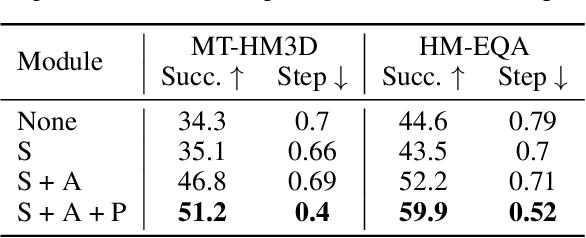

Abstract:Embodied Question Answering (EQA) requires agents to autonomously explore and understand the environment to answer context-dependent questions. Existing frameworks typically center around the planner, which guides the stopping module, memory module, and answering module for reasoning. In this paper, we propose a memory-centric EQA framework named MemoryEQA. Unlike planner-centric EQA models where the memory module cannot fully interact with other modules, MemoryEQA flexible feeds memory information into all modules, thereby enhancing efficiency and accuracy in handling complex tasks, such as those involving multiple targets across different regions. Specifically, we establish a multi-modal hierarchical memory mechanism, which is divided into global memory that stores language-enhanced scene maps, and local memory that retains historical observations and state information. When performing EQA tasks, the multi-modal large language model is leveraged to convert memory information into the required input formats for injection into different modules. To evaluate EQA models' memory capabilities, we constructed the MT-HM3D dataset based on HM3D, comprising 1,587 question-answer pairs involving multiple targets across various regions, which requires agents to maintain memory of exploration-acquired target information. Experimental results on HM-EQA, MT-HM3D, and OpenEQA demonstrate the effectiveness of our framework, where a 19.8% performance gain on MT-HM3D compared to baseline model further underscores memory capability's pivotal role in resolving complex tasks.
 Add to Chrome
Add to Chrome Add to Firefox
Add to Firefox Add to Edge
Add to Edge